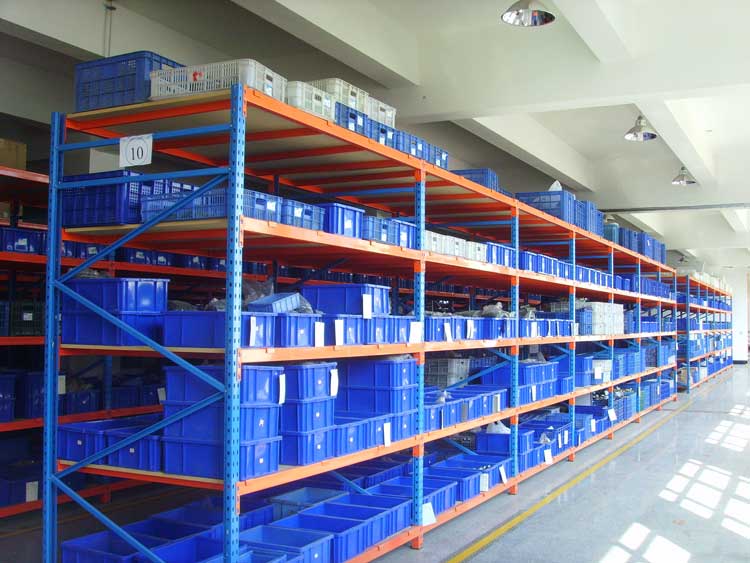In warehouses, retail backrooms, workshops, and parts storage areas, Longspan Shelving is one of the most versatile and effective solutions for storing medium-duty items, boxes, tools, and irregular goods. Unlike light-duty shelving or heavy-duty pallet racking, Longspan Shelving is ideal for hand-loaded, non-palletized, and mixed-size inventory.
This guide explains how to design a Longspan Shelving system that maximizes space utilization, improves picking efficiency, and supports long-term operational growth.
1. Define Your Storage Requirements and Constraints
Before you design the system, you must understand the conditions of your facility and inventory. This allows you to choose the correct specifications and layout.
Key questions to clarify:
✓ Inventory types and dimensions
Are you storing cartons, components, tools, equipment, or oversized items? Are product sizes consistent or highly diverse?
✓ Load capacity per level
Longspan Shelving typically supports 500 kg to several thousand kilograms per level, depending on beam length, decking, and frame design.
✓ Warehouse height and floor space
How much vertical space can you use? What is the available floor area?
✓ Aisle and workflow requirements
Consider walking aisles, material handling carts, ladders, or lifting equipment.
✓ Future growth and system scalability
Should the shelving support additional levels, new bays, or reconfiguration?
Having clear answers to these questions ensures that the shelving system fits your operational needs now and in the future.
2. Choose the Right Frames, Beams, and Decking
A Longspan system typically includes upright frames, load beams, and shelf decking. Selecting the right combination of these components determines the strength and versatility of the system.
Recommended specifications:
✓ Shelf height
Standard systems start at 2 m and can exceed 5–6 m for facilities with high ceilings.
✓ Shelf depth & beam length
Common depths include 600 mm, 800 mm, 1000 mm, and 1200 mm.
Beam lengths typically range from 1.8 m to 3.6 m, depending on system design and load needs.
✓ Decking materials
Choose based on product type:
- Particle board / MDF / OSB: economical and ideal for boxed goods
- Steel panels: strong and suitable for heavy or oily tools
- Wire mesh decks: safer, fire-friendly, and ideal for irregular items
✓ Adjustable levels
Choose a system that allows 50 mm or similar incremental adjustments for easy reconfiguration.
✓ Structural reinforcement
For long spans or tall frames, consider:
- Back bracing
- Diagonal bracing
- Wall ties
These reduce sway and improve overall stability.
3. Plan the Layout — Maximize Space and Maintain Clear Workflow
A well-planned layout is essential for both warehouse efficiency and employee safety. Proper design should balance storage density with accessibility.
Layout guidelines:
✓ Measure your space accurately
Include walls, pillars, fire exits, uneven flooring, and any structural obstacles.
✓ Design proper aisles
Aisle widths must support your handling equipment and picking workflow. Avoid congested traffic and maintain smooth material flow.
✓ Use vertical space effectively
If the ceiling height allows, add more levels to increase storage capacity. Ensure that picking tools (ladders, platforms, etc.) match the design.
✓ Zone your inventory
Organize SKUs based on:
- Fast-moving vs slow-moving
- Heavy vs light goods
- Large vs small items
Place frequently accessed items at ergonomic heights to speed up picking operations.
4. Focus on Load Capacity, Safety, and Long-Term Durability
Safe and stable shelving is essential for daily operations. Proper load distribution and regular maintenance prevent risks and extend system lifespan.
Safety and stability tips:
✓ Respect load limits
Never exceed the rated capacity per beam level. Store heavier items on lower levels.
✓ Reinforce tall or wide systems
Use back bracing, side bracing, or wall-tie connections to prevent lateral movement.
✓ Prevent items from falling
Use front lips, dividers, wire mesh panels, or safety straps for irregular or slippery items.
✓ Schedule routine inspections
Regularly check for:
- Bent uprights
- Loose connectors
- Damaged decking
- Rust or structural deformation
Timely maintenance ensures the system stays safe and reliable for years.
5. Improve Operational Efficiency with Smart Organization
Even the best shelving design requires proper organization and workflow planning. These practices will help maximize the value of your Longspan Shelving system.
Operational recommendations:
✓ Implement clear labeling
Label shelf levels and bays to help staff find items quickly.
✓ Place items ergonomically
Store frequently used items between waist and chest height to reduce pick time and fatigue.
✓ Organize by weight and size
- Heavy items → lower levels
- Light items → upper levels
- Large irregular items → dedicated sections
✓ Plan for future expansion
Choose modular designs that allow you to add new levels, bays, or reinforcements without removing the existing structure.
6. Common Mistakes to Avoid When Designing Longspan Shelving
To ensure your investment delivers long-term value, avoid these common pitfalls:
✓ Oversized beam spans without proper bracing
✓ Aisles that are too narrow for picking workflows
✓ Uneven or excessive loading of shelf levels
✓ Ignoring maintenance and inspections
✓ Failing to plan for SKU growth or layout changes
By anticipating these issues early, you prevent costly redesigns and safety hazards later.
Conclusion
Designing a Longspan Shelving system requires balancing space, load capacity, workflow patterns, and future scalability. By defining storage needs clearly, choosing the correct components, planning efficient layouts, and prioritizing safety, you can create a system that maximizes storage density while improving daily operational efficiency.
If you need help creating a Longspan Shelving layout plan, checklist, or product comparison, feel free to ask—I’m happy to support your next step!
Post time: Nov-25-2025

